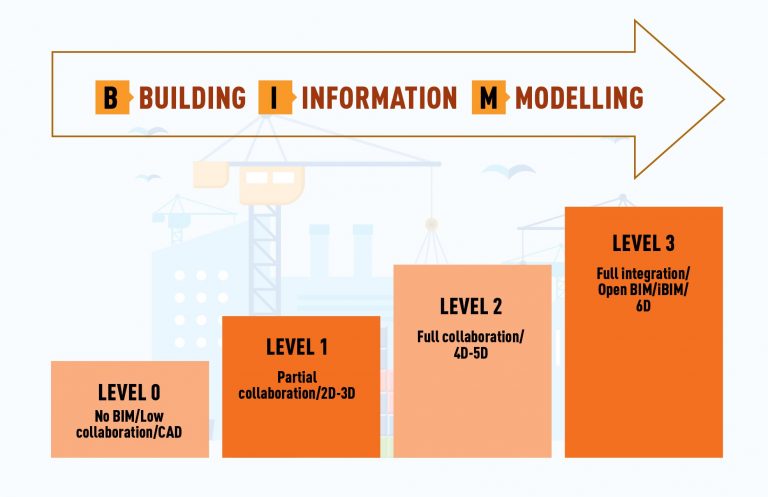One of the standardized tools to measure the degree of implementation (or maturity) BIM in a project is precisely the BIM Levels. It is a simple scale created by the government of the United Kingdom (NBS) that allows us to quickly recognize at what stage we are with respect to the use of BIM in our projects.
These have been defined within a range from 0 to 3. They are progressive and to reach each of them it is necessary to implement new processes and improve the pre-existing ones and whilst there is some debate about the exact meaning of each level, the broad concept is as follows:
Level 0 BIM
In its simplest form, level 0 effectively means no collaboration. 2D CAD drafting only is utilised, mainly for Production Information (RIBA Plan of Work 2013 stage 4). Output and distribution is via paper or electronic prints, or a mixture of both. The majority of the industry is already well ahead of this now (source: NBS National BIM Report 2017).
Level 1 BIM
This typically comprises a mixture of 3D CAD for concept work, and 2D for drafting of statutory approval documentation and Production Information. CAD standards are managed to British Standards (BS 1192:2007), (different countries apply different standards), and electronic sharing of data is carried out from a common data environment (CDE), often managed by the contractor.
This is the level at which many organizations are currently operating, although there is no collaboration between different disciplines – each publishes and maintains its own data.
Level 2 BIM
This is distinguished by collaborative working – all parties use their own 3D CAD models, but not necessarily working on a single, shared model. The collaboration comes in the form of how the information is exchanged between different parties – and is the crucial aspect of this level.
Design information is shared through a common file format, which enables any organization to be able to combine that data with their own in order to make a federated BIM model, and to carry out interrogative checks on it. Hence any CAD software that each party used must be capable of exporting to one of the common file formats such as IFC (Industry Foundation Class) or COBie (Construction Operations Building Information Exchange). This is the method of working that has been set as a minimum target by the UK government for all work on public-sector work, by 2016.
Level 3 BIM
Currently seen as the holy grail, this represents full collaboration between all disciplines by means of using a single, shared project model which is held in a centralized repository. All parties can access and modify that same model, and the benefit is that it removes the final layer of risk for conflicting information.
This is known as ‘Open BIM’.
4D BIM and beyond
Finally, the concept of ‘4D’ BIM has become a buzzword in recent years. This equates to the use of BIM data to analyze time; beyond this are ‘5D’ which includes cost management, and ‘6D’ for facilities management (FM) purposes.
The significance of these steps, in real terms, is that UK government has adopted this definition in its Construction Strategy, by requiring that all publicly-funded construction work must be undertaken by using Building Information Modelling to Level 2, by 2016. This mandate has been set as one measure to help in fulfilling their target of reducing waste in construction by 20%. It is considered that abortive work, discrepancies and mistakes, and inefficiencies in the information supply chain are major contributors to this waste; and that collaborative working can assist in their reduction. Looking further ahead, it is highly probable that collaborative working practices will ultimately filter through to the private sector, in much the same way that CAD took over from the drawing board during the 1990s.
